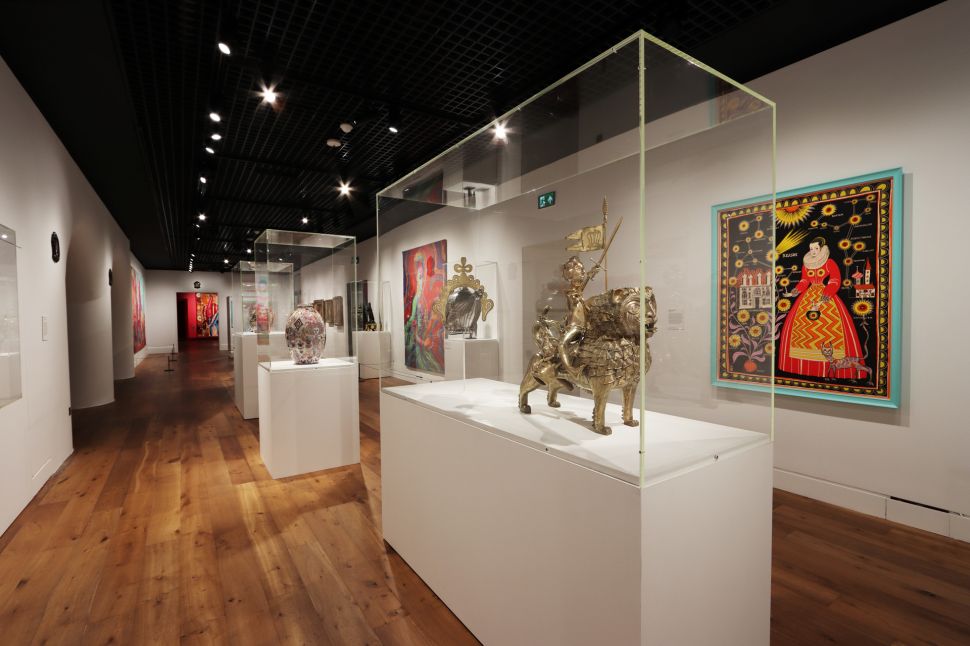Grayson Perry in a white-walled gallery, including a golden sculpture of a knight riding a lion, a decorated ceramic vase, and a brightly colored framed textile piece on the wall.” width=”970″ height=”647″ data-caption=’Perry plays with the ascribed femininity of 18th-century French Rococo and the ascribed masculinity of arms and armor. <span class=”lazyload media-credit”>Cassandra Parsons</span>’>
The Wallace Collection in London is brimming with fine and decorative arts: oil paintings from the 14th Century, Limoges enamel, 18th-century chests of drawers veneered with mahogany and Renaissance objects. This solemn reservoir is on view in Hertford House—the distinguished former residence of the collection’s namesake Sir Richard and Lady Wallace—in a lavish manner that reflects the moneyed tastes and lifestyle of its founders.
What could disrupt such a stately array? Well! English artist Grayson Perry (b.1960) remixes the on-site references—grandiose to some, stodgy to others—in “Delusions of Grandeur.” As someone who has, at every step of his career, dismantled the snobbery of the art world and espoused accessibility at the heart of creativity—he wrote Playing to the Gallery: Helping Contemporary Art in Its Struggle to Be Understood a decade ago—this setting seems in contradistinction to his ethos. But the 40 new works here were made to willfully skewer wealth, not champion it.
SEE ALSO: Getty’s Glenn Phillips On Securing Raymond Pettibon’s Archive
Moreover, as someone who has deconstructed and reimagined gender roles in his creations and in his life (he’s long been vocal about being a cross-dresser), he was compelled to explicitly play with the ascribed femininity of 18th-century French Rococo and the ascribed masculinity of the arms and armor (or what the press release dubbed “the gendering of decoration”).
Perry flips assumptions about identity via ceramics, tapestries, furniture. Many are handcrafted, but these join pieces made with A.I.-generated images of Perry as his alternate persona, Shirley Smith: tiara-topped and holding a rifle, sitting casually on a swing with unkempt bleached hair askew. Perry’s custom works, whether classically crafted or digitally enhanced, are displayed alongside a selection of the Wallace Collection’s holdings, which Perry created in direct or indirect response to. Perry writes in one of the wall captions: “I struggled with the opulent aesthetic, which I found cloying at times. Fortunately, I worked out a strategy that helped me find a fresh perspective.” Incidentally, Perry wrote all the exhibition captions and narrates the audioguide.
As part of his reappraisal of the museum’s history: “I wanted to look at the sophistication and refinement of the collection through the eyes of an ‘outsider artist,’ so have made something in the style of a self-taught art sculpture,” he writes alongside Man of Stories, his ceramic/mixed media work spiky with beads and pebbled, embodied by a silhouette in a crinkled blue cape covered with pins (“BREX SHIT,” “Campaign against living miserably,” “Fuck the Tories”).
“Delusions of Grandeur” opens with works by visionary outsider artists Aloïse Corbaz and Madge Gill—Gill exhibited at the Wallace Collection in 1942. The latter’s girlish figures, drawn against graphically intricate, dense backgrounds, are undated, executed in colored ink on paper. These resonate wonderfully with a selection of pen and colored pencil drawings done by Perry’s surrogate, Shirley Smith—a mentally ill woman who believes herself to be the heir to Hertford House and its vast valuables—featuring similarly naive, detailed settings and characters: an adolescent girl clasping a doll in a plush bed as she’s served tea on a tray, or a bow-adorned mother in bishop sleeves reading to her daughter as a servant stands obediently by. Perry’s aesthetic is self-described at one point as “somewhere between upper-middle-class Victorian child and 1970s Laura Ashley garden party.”
His caption for What a Wonderful World, one of his glazed ceramics—upon which posh women in high-collared dresses state in speech bubbles, ‘We deserve everything’—sizzles with scorn. “Whenever I find myself crossing into ‘West London’… I imagine I can smell a great sense of entitlement emanating from the people who live in a cosseted bubble of beige international wealth.” Perry admits his own success has made him more adjacent to this rung of society than his impecunious origins. But his criticism of wealth is underpinned by his self-awareness of his privilege: he side-eyes prosperity at the expense of communal and social values.
In another glazed ceramic effort, two busts—titled Serious People—flank a brightly-colored tapestry fashioned from 1960s/70s fabrics called Fascist Swing, a pastiche of Jean-Honoré Fragonard’s 1768 painting The Swing. Rather than dignified homage, Perry describes the busts as “party balloons about to burst,” and the frothy nature of Fragonard’s original is flipped into a Lisa Frank-hued night terror. Perry points out: “Seriousness is a sought-after commodity in art, but in its attempts to be significant, it can easily shade into earnestness and pomposity.” Even when it falls into pomposity, he is not dismissive and still can connect to the art: he admits to being “drawn to all those swooning women by Greuze, Schopin, and Boilly” because humans always seek to connect—however far-fetched an art narrative might be from one’s own life.
In the final room, wallpapered in a patterned bubblegum pink design Perry collaborated on with Liberty, an altarpiece and six oversized ceramic plates stand on either side of an orange bedframe with an appliquéd bedspread. Along the bottom of the bedspread is a classic delusion of grandeur line: “I know who I am.” Across the room, a beribboned Madame De Pompadour (the 1759 oil painting by François Boucher) smiles placidly from an ornate frame, in contrast to the wool prayer rug on which Shirley Smith is passed out on the floor. It’s a perfect mélange of femininities: poised versus chaotic, superficial versus warped. Undeniably, Perry’s irreverent version of grandeur is much more fun than the real thing.
Grayson Perry’s “Delusions of Grandeur” is at the Wallace Collection through October 26, 2025.

